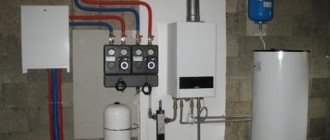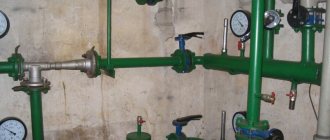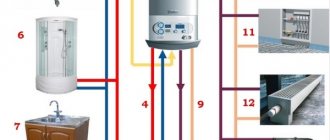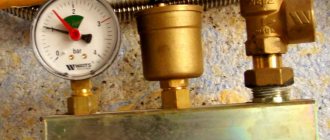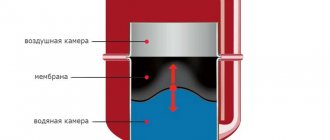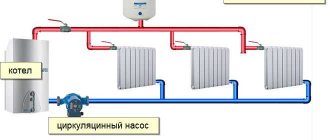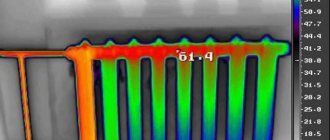What is the brand of cable
The wire grade is a letter designation that characterizes the material of the current-carrying conductors, insulation, degree of flexibility and design of protective covers. The following designations are used in the labeling of domestic goods:
- The first letter indicates the material of the conductor (say, A - aluminum). The absence of a letter in the brand means that the conductor is made of copper.
- The second letter represents the wire.
- The third is the insulation material (for example, R - rubber, B - polyvinyl chloride, P - polyethylene).
Marks of wires and cords may also contain letters characterizing other structural elements:
- O - braid.
- T - for installation in pipes.
- P - flat.
- F - metal folded shell.
- G— flexible, etc.
Types of wire
Differences between open and closed heating systems
There are the following distinctive features of open and closed heating systems:
At the location of the expansion tank. In an open heating system, the tank is located at the highest point of the system, and in a closed system, the expansion tank can be installed anywhere, even next to the boiler. The closed heating system is isolated from atmospheric flows, which prevents air from entering. This increases service life. By creating additional pressure in the upper components of the system, the possibility of the formation of air locks in radiators located on top is reduced. An open heating system uses pipes with a large diameter, which creates inconvenience, and the installation of pipes is carried out at an angle to ensure circulation. It is not always possible to hide thick-walled pipes
To ensure all hydraulic rules, it is necessary to take into account the slopes of flow distribution, lifting heights, turns, narrowing, and connections to radiators. A closed heating system uses smaller diameter pipes, which reduces the cost of the design.
Also, in a closed heating system, it is important to install the pump correctly to avoid noise.
Advantages of an open heating system
- easy system maintenance;
- the absence of a pump ensures silent operation;
- uniform heating of the heated room;
- quick start and stop of the system;
- independence from power supply, if there is no electricity in the house, the system will be operational;
- high reliability;
- no special skills are required to install the system; first of all, the boiler is installed; the power of the boiler will depend on the heated area.
Disadvantages of an open heating system
- the possibility of reducing the service life of the system if air enters, as heat transfer decreases, resulting in corrosion, water circulation is disrupted, and air pockets form;
- air contained in an open heating system can cause cavitation, which destroys system elements located in the cavitation zone, such as fittings and pipe surfaces;
- the possibility of freezing of the coolant in the expansion tank;
- slow heating of the system after switching on;
- constant monitoring of the coolant level in the expansion tank is necessary to prevent evaporation;
- impossibility of using antifreeze as a coolant;
- quite bulky;
- low efficiency.
Advantages of a closed heating system
- easy installation;
- there is no need to constantly monitor the coolant level;
- possibility of using antifreeze. without fear of defrosting the heating system;
- by increasing or decreasing the amount of coolant supplied to the system, you can regulate the temperature in the room;
- due to the absence of water evaporation, the need to replenish it from external sources is reduced;
- independent pressure regulation;
- the system is economical and technologically advanced, has a longer service life;
- possibility of connecting additional heating sources to a closed heating system.
Disadvantages of a closed heating system
- the most important drawback is the system’s dependence on the availability of a constant power supply;
- the pump requires electricity to operate;
- For emergency power supply, it is recommended to purchase a small generator;
- if the tightness of the joints is broken, air may enter the system;
- dimensions of expansion membrane tanks in large enclosed spaces;
- the tank is filled with liquid by 60-30%, the smallest percentage of filling occurs in large tanks; at large facilities tanks with a design volume of several thousand liters are used.
- There is a problem with the placement of such tanks; special installations are used to maintain a certain pressure.
Everyone who is going to install a heating system chooses which system is simpler and more reliable for him.
Due to its ease of operation and great reliability, an open heating system is used for optimal heating of small rooms. These can be small one-story country houses, as well as country houses.
A closed heating system is more modern and more complex. It is used in multi-storey buildings and cottages.
How to run a closed system
Before turning on the heat supply after assembling the pipeline and equipment, you need to fill the pipes with operating fluid and carry out operational checks. The first time filling a closed heating system is carried out in compliance with the following rules:
- It is necessary to close all drain valves and air vents;
- Open the valves on the heat carrier supply pipe and on the return pipe of the cooled water of the heating circuit (on the return);
- To fill the coolant, the water hose must be connected to the liquid supply valve to the circuit, and the pressure in the pipes should not be more than 1.5-2 bar. When the readings of the device for determining the pressure increase, the supply is shut off;
- After which the air is released by opening the air vents, after which the pressure will drop slightly;
- The water supply valve must be opened again and added to the heating circuit so that the device for determining the pressure shows 1.5 bar, after which the valve can be closed;
- After the system is completely filled and all the air has been released, you can begin checking the functionality of the equipment.
The main thing: When leaks are detected in pipes or fittings, filling of the heating distribution pipes ends, leaks are removed by replacing parts or repairs, after which the system must be filled according to the rules.
If, upon completion of filling the water and after starting the heating supply, it is discovered that the heating devices do not heat well, some parts stand out in temperature from the general indicators, the movement of water along a closed circuit is slow or absent in some areas, then this means one thing - there is air and pipes left in the system you need to blow it out, in other words, remove the air pockets. This is done with the help of air vents, and after releasing the air, you need to drain a certain amount of liquid in order to be sure of the complete absence of oxygen in the water mass.
Purge is best carried out at a very high pressure of the coolant in the system. This can be achieved by opening the make-up valve from the cold water supply. Repeating the operation once or twice ensures complete removal of air plugs from the heating circuit. In most cases, this applies only to a closed circuit - an open system is filled much better, since the air also exits through the expansion tank, but such a solution is only permissible for small or townhouses.
Automatic and manual recharge
But the question of which heating system is better, closed or open, remains open unless you find out the need to use manual or automatic replenishment of the coolant
.
In a closed pipeline, high pressure must remain constant. Even very small losses and leaks (for example, when opening an air vent), adding up, reduce the pressure and reduce the efficiency of the entire circuit, which none of those living in the house will be happy about in the winter. To compensate for this deficiency, the closed
circuit must be recharged with a new volume of coolant.
For conventional and small heating systems, in most cases a mechanically controlled faucet is used. It is mounted at the point of lowest pressure, which is located in front of the circulation pump. At this point, a device is installed to determine the pressure value to control the replenishment process. To prevent the penetration of the heat carrier into the water main, a shut-off valve is used.
, heating systems are automatically recharged; the price of the recharge valve depends on the brand of the manufacturer. Sometimes automated make-up valves are part of the boiler equipment. If the replenishment is carried out from a water metering unit, in which the pressure in most cases is 3 - 4 bar, then everything happens very simply. Factory valve setting is 1.5 bar.
If the pressure in the heating system drops below 1.5 bar, the valve will open and remain open until the set pressure is reached. If automatic replenishment will use coolant from other sources, then a pump is needed that will be turned on by a signal from the valve and supply coolant
under a specific pressure into the heating system.
Automatic temperature adjustment
How to automate and select the appropriate mode in your home, especially when you are often away from an apartment or in a private house outside the city. Quite easy, necessary for heating systems
purchase a controller - a device that allows you to program and control the temperature in the house. Before purchasing a heating controller, make sure that the boiler has a suitable control unit. The best option is consultation with professionals.
One of the most suitable automation options comes out when using beam (collector) wiring. Special valves are mounted on the comb, which are controlled by the control unit of the multi-channel controller. This control unit gives a signal to turn on the boiler.
All rooms have a separate thermostat, which is set to a specific temperature. The multi-channel controller of the heating processes data from thermostats and, when the temperature in any room decreases, turns on the boiler and opens the valve of this room on the comb. In any case, the boiler will work until the temperature in each room reaches the programmed value.
How can you modernize an open heating system?
My colleagues and I often upgrade open heating systems. And the first thing we do is cut off the expansion tank on the roof. Instead, we cut a thread on a piece of pipe and mount an automatic air vent and properly insulate it.
Near the boiler, we install a circulation pump into the return pipeline through a bypass and a closed-type membrane expansion tank with a safety group.
Thus, we remove excess coolant volume. And this is from 50 to 200 liters. We eliminate heat loss due to the tank and we eliminate freezing of the connecting pipes of the tank, and we eliminate the rupture of the system and its failure.
Here you need to understand that if your system is old, then it may not withstand the pressure. This is why the safety valve on the safety group must be set to 1.5 bar. Otherwise, when the pressure in the system increases, it may leak. And in order to patch it up, it will have to be drained, a welder called in, and so on.
An open home heating system is often installed as a gravity system so as not to rely on electricity to operate the pump. Energy-independent floor-standing gas boilers can be installed into an open heating system. There are also special electric boilers with enlarged supply and return connections.
If you have such a heating system installed and there is no interruption in the power supply, then you can install any energy-dependent boilers. It must be remembered that often open heating systems are made of steel pipes. Therefore, when installing new boilers into them, it is necessary to install mesh filters in front of the boilers. In order to prevent the ingress of scale and rust into them.
Why are they called closed or closed?
The pump creates a slight increased pressure in front of the fluid and a vacuum behind the impeller. If the system has an open expansion tank and atmospheric pressure, then it is possible that the liquid will simply pour out of it or other hydraulic troubles will occur... For normal operation, there must be a slight increased pressure in the system, the norm is 1.5 - 2.0 atm for an unheated state .
To maintain increased pressure, the system is closed and a closed-type membrane expansion tank is used, one half of which is initially pumped with air to a pressure of 1.3 - 1.4 atm. Now, during thermal expansion, the liquid does not escape “into the pan”, but its excess part compresses the air in the tank and the pressure in the system increases slightly. The heating system turns out to be closed (closed).
We recommend: Insulating a wooden house with mineral wool from the outside under siding - step-by-step instructions
Criteria for choosing a heating system
There are only two options to choose from - a closed or open home heating system. Has anyone ever wondered why the first systems created were only open? And they were open for one simple reason - the boilers that heated the water were solid fuel. When circulation stops, the water in the boiler boils; a safety valve prevents the boiler from exploding, but it is impossible to extinguish it quickly. Therefore, closed heating systems with forced circulation began to be used for electric and gas boilers, which can be turned off automatically at any necessary time.
Open heating system
The open heating system is currently considered obsolete and is used in small private houses and country cottages. In this case, it is necessary to install an expansion tank in an open heating system at the highest point of the accelerating manifold to ensure circulation under the influence of gravity.
The modern open circuit of the heating system has borrowed the most important unit from a closed system - the circulation pump. It is usually used when starting a system to reduce its inertia. Then, during operation, the pump turns off and the bypass opens. Knowing where to place the pump in the heating system is necessary for its reliable and long-term operation. The pump is installed at the point with the lowest coolant temperature, usually in the “return” near the boiler.
The system is called “open” because atmospheric air is constantly in contact with water in an open expansion tank.
The open system is simple, reliable, and its cost is minimal. There is a misconception that its installation is more expensive because such systems require larger diameter pipes. If we take into account the cost of a circulation pump, a membrane expansion tank and electricity costs for a closed heating system, then installation will clearly not be cheaper. In some cases, there is no alternative to using an open heating system. For example, in the absence of power supply.
The main advantages of open heating systems:
- extreme ease of installation and maintenance;
- quiet operation;
- energy independence;
- reliable operation with boilers of any type;
- relatively low costs for the purchase of equipment, pipes and fittings.
Of course, a simple and reliable open heating system, usually a two-pipe design, is not without its drawbacks:
- evaporation of liquid in the expansion tank makes it impossible to use antifreeze; the water level in the tank must be monitored;
- large inertia of the system; to eliminate this drawback, a circulation pump and bypass are installed;
- For complex contours of multi-storey buildings with heated floors, the system is not suitable due to the high hydraulic resistance of such heating systems.
Closed heating system
If you choose a closed-type heating system, the scheme of which can be any - single-pipe or double-pipe, with or without heated floors, then its main feature is the absence of contact of the coolant with air, i.e. it is completely sealed. The movement of the coolant in the circuit is ensured by a circulation pump. and the thermal expansion of the liquid is compensated in a sealed membrane expansion tank. The use of forced circulation facilitates installation, because there is no need to strictly maintain the slope of pipes, which may be of smaller diameter. The presence of a pump makes the system energy-dependent.
With the increase in the number of floors of private houses and the complexity of heating circuits, a closed-type heating system is mainly used, which may include several circulation pumps, collector beam distribution and automated electronic control of the temperature of different rooms. In a closed circuit, the installation scheme of the expansion tank in the heating system differs from its placement in an open system. The best option is to place a membrane tank in the “return” near the boiler.
The popular closed heating system has both advantages and some disadvantages:
- in a closed system there is completely no evaporation, therefore, antifreeze can be used as a coolant;
- relatively lower costs for circuit pipes; pipes can be hidden under the floor or trim;
- installation is simplified; there is no need to carefully measure the angles of inclination of the pipeline;
- low system inertia and high heat transfer;
- a small amount of oxygen in the coolant reduces corrosion of steel pipes.
Closed heating system - pros and cons
The closed heating circuit differs from the previous one in its own tightness and lack of air in the system. The system itself can be varied - one- or two-pipe, with vertical and/or horizontal risers, since the movement of liquid through the pipes is ensured by the operation of the pump, and the expansion of water when heated is compensated by the shift of membrane tissue in a sealed expansion tank. Forced circulation of antifreeze or water makes the installation of the circuit simple and quick, since there is no need to slope or turn the pipes, and the pipes can be of various diameters and even smaller than the calculated one.
Moreover, the differences in these two solutions are that an open heating system is useless in high-rise buildings due to a significant difference in pressure at the bottom and top of the wiring - the difference in values reaches 1-2 Atm. In the same high-rise buildings, a closed circuit with one or more pumps, collectors and an automatic control and monitoring system will operate without fail.
But, having made a closed circuit, you must always remember about some of its negative aspects:
- Energy dependence of the pump and automation;
- Difficult installation for 2 or more floors of the house;
- In a closed-open heat supply scheme, the coolant , thanks to this the system will work without freezing;
- All wiring or most of it can be hidden in the walls or in the floor;
- There is no need to tilt the pipes or rotate the angle, since the pump will push the coolant through any pattern;
- Low inertia of heat transfer and high heat transfer coefficient of all units and components;
- The absence of air in the pipes inhibits the formation of rust on the walls inside the products.
Heating network pipes
Currently, domestic ones are in disrepair. Due to the high wear and tear of communications, it is cheaper to replace the pipes for the heating main with new ones than to engage in constant repairs.
It is impossible to immediately update all old communications in the country. During the construction or major renovation of houses, new pipes are installed to reduce heat loss several times. Pipes for the heating main are made using a special technology, filling the gap between the steel pipe located inside and the shell with foam.
The temperature of the transported liquid can reach 140°C.
Using polyurethane foam as thermal insulation allows you to retain heat much better than traditional protective materials.
Two-pipe heating system
The operating principle of a two-pipe heating system is somewhat different from that described above. In this case, the coolant rises along the riser and is supplied to each heating radiator. And then it returns through the return line back into the pipeline, which transports it to the heating boiler.
With this scheme, the radiator is served by two pipes - supply and return, which is why the system is called two-pipe.
What advantages does this arrangement provide?
What can you expect if you choose this option for organizing the heating of a private and residential apartment building?
- Such a system allows you to organize uniform heating of each radiator. Any battery, no matter what floor it is on, receives hot water at the same temperature. If desired, you can install a thermostat on the radiator, and then the weather in the house can be independently adjusted. The use of a thermostat in a separate room does not affect the heat transfer of radiators installed in other apartments.
- In a two-pipe system, there are no large pressure losses during coolant circulation. Therefore, a powerful hydraulic pump is not needed for the normal functioning of the system. Water is able to circulate due to gravitational force, that is, by gravity. And if the water pressure is weak, it is enough to install a low-power pumping unit, which is more economical and easier to maintain.
- With the help of shut-off equipment, bypasses and valves, it is easy to organize such circuits that will allow you to repair, if necessary, one heating device without turning off the entire heating of the house.
- Another additional bonus of a two-pipe piping is the ability to use the associated and dead-end movement of hot water.
What is a passing scheme? This is when water both in the supply and return flows in the same direction. In a dead-end circuit, supply and return water circulates in opposite directions. When driving in parallel, provided that radiators of the same power are used, ideal hydraulic balancing is established. Therefore, there is no need to additionally use battery presetting valves.
If heating devices have different power, you will have to calculate the heat loss of each, carry out calculations and link the radiators using thermostatic valves. It is very difficult to do this yourself without knowledge and skills.
Note! Associated hydraulic gravity flow is used where long-distance pipelines are installed. For short systems, a dead-end coolant flow pattern is used
Classification of two-pipe heating system
The classification of two-pipe piping is made according to the location of the pipeline and the method of arranging the distribution system.
According to the location of the pipeline, it is divided into vertical and horizontal. In a vertical scheme, all batteries are connected to a vertical riser. This option is most often used in apartment buildings. The main advantage of this connection is the absence of air locks.
For a private house with a large area, experts recommend choosing horizontal two-pipe wiring and installing a Mayevsky tap in each radiator. It is needed to bleed air, and an example of its correct installation has been described in detail more than once in previous articles.
According to the wiring method, a two-pipe system can have lower and upper piping. In this case, the hot water supply riser is placed in the basement or basement. The return line is located here, but is installed below the supply. All radiators are located at the top. An upper air line is connected to the common circuit, allowing excess air to be removed from the system.
When installing the top trim, the entire distribution line is mounted in the insulated attic of the building. An expansion tank is also installed there. This scheme cannot be used if there is a flat roof.
Disadvantages of a two-pipe system
Comparing two battery wiring schemes, it is easy to conclude which is better. The two-pipe one is in any case much more efficient. But it has one significant drawback. Its assembly will require twice as many pipes. In addition, they come with a large number of fasteners, valves and fittings, so installation of a two-pipe system is much more expensive.
Until recently, when steel pipes and labor-intensive welding processes were used to assemble a two-pipe piping, the cost was prohibitive. With the advent of metal-plastic and hot soldering technology, laying a two-pipe main has become accessible to almost everyone.
Two pipe system
There are several types of it. The principle of operation is the same and is as follows. Hot water rises through the riser and flows from it into the radiators. And from them, through highways and return lines, it enters the pipeline, then into the heating device. With this system, the radiator is served by two pipes simultaneously: return and supply, which is why it is called two-pipe. The water in this system is supplied directly from the water supply. She needs an expansion tank, which can be either simple or with water circulation.
Scheme of a two-pipe heating system with a circulation pump.
The simple one includes a container with 2 pipes. One is a water supply riser, and the second is used to drain excess liquid.
A more complex design has 4 pipes. 2 pipes provide circulation, and 2 others are needed for control and overflow, they also monitor the water level in the tank.
Two-pipe systems can be operated using a circulation pump. Depending on the circulation method, it can be with a passing flow or dead-end. In the second, the movement of warm water is completely opposite to the direction of the already cooled water. This scheme is characterized by the length of the circulation rings, which depends on the distance of the heating device to the boiler. The circulation rings are of equal length in systems with one-way water movement, all devices and risers operate under equal conditions.
A two-pipe heating system has a large set of advantages compared to a single-pipe one:
- the ability to distribute heat supply in different rooms;
- can be used on one floor;
- the shut-off systems for the return and supply risers are located in the basement - this significantly saves living space;
- minimizing heat loss.
The only drawback is the considerable consumption of materials: you need 2 times more pipes than for a single-pipe connection. Another disadvantage is the low water pressure in the supply line: taps will be needed to bleed air.
A horizontal closed two-pipe circuit comes with lower and upper wiring. The advantage of lower wiring: sections of the system can be put into operation gradually, as floors are built. The vertical two-pipe scheme can be used in houses with variable number of storeys. Any of the varieties of two-pipe circuits is more expensive than single-pipe horizontal wiring; for the sake of comfort and design, it is worth giving preference to the two-pipe circuit.
Components of a closed heating circuit
The difference from the gravity system is the need to install specific components. Some of them are necessarily used in a closed system, but are sometimes used in natural circulation. The source of thermal energy is boilers. Some of the wall-mounted gas, pellet, and solid fuel models are immediately equipped with the necessary safety group. If it is not available, it must be purchased separately and installed on the hot water pipe.
The sealed tank maintains pressure and compensates for the volume of coolant. Its efficient movement is ensured by a circulation pump, which is recommended to be installed on the return line near the boiler itself. This arrangement is dictated by the fact that the water in this place is quite cool, the device is less susceptible to overheating. The remaining elements are the same as in the gravitational system: pipelines, radiators or registers.
Selection of equipment, pipes and radiators
Before you begin choosing a source of heat generation for a closed heating system, you need to carefully approach the issue of choosing the type of energy from which heat will be generated. Indeed, on the modern market there is a huge number of electric, solid and liquid fuel, as well as gas boilers. It is necessary to take into account all connection costs and the nuances of subsequent operation and choose the appropriate option, depending on the area and climate of the region.
Double-circuit gas boilers with automatic control already have a pressure-compensating tank and a pump responsible for circulation. If you choose a simpler boiler, you will need to purchase additional equipment.
Some designs already have a tank, some do not.
Expansion tanks can be dismountable (if the membrane bursts, you can replace it yourself) and non-dismountable, if they fail, the entire tank is replaced.
The volume of the tank for this type of heating of buildings directly depends on several parameters, and you need to choose it according to them:
- volume of coolant in the system (tank volume 10% of the liquid volume);
- maximum temperature value.
The heart of the entire closed heating system of a private house is the circulation pump, and the further efficiency of its operation will depend on its parameters. The choice of pump power depends on many indicators of the length and diameter of the pipes, the material from which the heat exchangers are made and their quantity, operating mode
If the pump is installed in a residential area, you should pay attention to the level of noise produced, this may affect the quality of your stay.
How and where to install an expansion tank for heating:
A large number of types of radiators allows you to make a choice according to your preferences:
- radiators made of cast iron are massive, have a lot of weight, take a long time to gain temperature, but at the same time cool down slowly, and are not afraid of low-quality water and pressure changes;
- made of aluminum alloy, they have a beautiful shape, are light in weight, heat up quickly, but are more expensive and are susceptible to water hammer;
- steel radiators are inexpensive and of good quality;
- made of a bimetallic alloy, as a rule, are of good quality, heat up quickly and transfer heat well.
Depending on which pipes are selected, you will need to remember about additional materials, such as couplings
There are several types of pipes on the market:
- from different metals;
- from polymers (plastic, polyethylene and polypropylene).
When installing heating systems using pipes made of any metal, welding and a large number of bends, angles and couplings will be required. The use of metal-plastic pipes requires a large number of fittings and constant monitoring of connections. For a closed heating circuit, plastic pipes are most often chosen (for ease of installation and the ability to hide pipes in the walls). Manufacturers usually indicate in the specifications whether the pipes can be used in heating systems or only for cold water.
A simple do-it-yourself heating system in a private house:
What to consider when installing any system
Heating boiler operating diagram.
It is important not to forget to install regulating thermal valves at the inlet and outlet of the radiator, as well as a drain valve, which is usually located at the lowest point of the heating structure. Purchasing used or “cheap” pipes and fittings in any heating system can later result in very serious problems requiring major repairs not only of the entire heating structure, but also of the house itself due to the possible rupture of hot water pipes and its flooding. Purchasing used or “cheap” pipes and fittings in any heating system can later result in very serious problems requiring major repairs not only of the entire heating structure, but also of the house itself due to the possible rupture of hot water pipes and its flooding
Purchasing used or “cheap” pipes and fittings in any heating system can later result in very serious problems requiring major repairs not only of the entire heating structure, but also of the house itself due to the possible rupture of hot water pipes and its flooding.
Two-pipe heating distribution is possible for a private house with any number of floors. And its operation can occur without the use of a circulation pump. But these systems have rather low efficiency and are no longer used by many people nowadays.
https://youtube.com/watch?v=IVHMLLJRL6M
When deciding to place a two-pipe distribution system with a collector in a house, you need to carefully consider and plan the placement of the coolant distribution unit, the so-called comb. It will be correct to make the length of the pipes extending from it commensurate, since a significant difference in length from the comb to the radiators can lead to a significant difference in pressure. And this will complicate the adjustment of the system as a whole. The best solution for placing the comb is such that there is approximately an equal distance from each of the radiators.
Pipes for heating installations can be copper, steel, polypropylene and metal-plastic, but in no case should they be galvanized. The required type of pipes is selected depending on the construction project and the preferred characteristics: economic, environmental. But hydraulic characteristics should be a priority.
The flow rate of the pipes required for laying this system will depend on the chosen heating distribution scheme (two-pipe or one-pipe). Private houses with a large area require the equipment of a two-pipe system, into which a circulation pump is also installed. Temperature control in each room is carried out using thermostats.
Myth 2: according to the type of connection of the building to heating networks
Closed systems (meant in this context) are building heating systems that are connected to external heating networks through a heat exchanger. That is, the consumer’s heating system is not connected in any way to external networks, hence the name “Closed”.
In fact, this type of connection is correctly called Independent (Fig. 3).
Fig.3. Scheme of independent connection of the heating system to heating networks
With this connection, the coolant from the source (CHP) circulates through the heat exchanger, giving off heat.
When designing the entire heating system of an object, for example, a residential apartment building, it becomes clear what type of heat exchangers is suitable: shell-and-tube, shell-plate, or it is necessary to buy a plate heat exchanger.
The heat exchanger is installed in the building’s individual heating unit (IHP).
Currently, this type of connection is replacing the outdated one - Dependent.
Open systems are heating systems connected directly to heating networks or through an elevator. In this case, the coolant comes from external heating networks to the end consumer, having previously passed through an elevator to lower the temperature.
The supply temperature in heating networks is 110-150 °C; such a hot coolant cannot be used in heating systems, as burns from radiators and pipelines will be possible.
The elevator, in addition to lowering the temperature of the coolant, performs one more function - it creates the pressure that is necessary for the movement of the coolant in the intra-house system (Fig. 4).
Fig.4 Diagram of dependent connection of the heating system
It would be correct to call such a connection Dependent.
Heat supply of multi-apartment residential buildings
Unlike a dacha or cottage, the heat supply of an apartment building contains a complex layout of pipes and heaters. In addition, the system includes control and security controls.
For residential premises, there are heating standards that indicate critical temperature levels and permissible errors, depending on the season, weather and time of day. If you compare closed and open heat supply systems, the first one better supports the necessary parameters.
Communal heat supply must ensure the maintenance of basic parameters in accordance with GOST 30494-96.
The greatest heat losses occur in the stairwells of residential buildings.
Heat supply is mostly produced using old technologies. Essentially, heating and cooling systems must be combined into a common package.
The disadvantages of centralized heating of residential buildings lead to the need to create individual systems. This is difficult to do due to problems at the legislative level.
Drawing up a heat supply diagram
The heat supply scheme is a pre-design document that reflects legal relations, conditions for the functioning and development of the heat supply system for an urban district or settlement. In relation to it, federal law includes certain norms.
- for settlements are approved by executive authorities or local governments, depending on the population.
- For the corresponding territory there must be a single heat supply organization.
- The diagram indicates energy sources, indicating their main parameters (load, work schedules, etc.) and range.
- Measures are indicated to develop the heat supply system, conserve excess capacity, and create conditions for its uninterrupted operation.
Heat supply facilities are located within the boundaries of the settlement according to the approved scheme.
Differences between open and closed systems
- Location of the expansion tank. In an open system, the tank must be located at the highest point, but a closed heating system does not impose any requirements on the location of the tank.
- In a closed heating system, constant atmospheric pressure is maintained, since air does not enter such a system from outside (for more details: “Closed heating system - diagram with examples”). Due to this, the heating service life is significantly increased. Additional pressure at the top of the system reduces the risk of air pockets clogging the radiators located on top.
- An open heating system requires large diameter pipes, which are quite inconvenient during installation and operation. In addition, they are quite difficult to disguise, which negatively affects the design of the premises. For such a system to work, a constant slope is required, the creation of which requires additional effort.
- A closed system is structurally much simpler and cheaper, since the installation of thin pipes is less labor-intensive, and their cost is much lower than the cost of thick pipes.
- If the circulation pump is installed correctly, constant noise can be avoided.
- ease of operation;
- no need to install a pump;
- uniform heat distribution throughout the rooms;
- easy start and stop of the system;
- independence from electricity;
- reliability;
- simplified installation.
- deterioration of the wear resistance of the system when air enters it;
- poor resistance to low ambient temperatures during intermittent operation;
- slow warm-up after startup;
- the need to constantly monitor the coolant level in the expansion tank;
- incompatibility of the system with antifreeze;
- large dimensions;
- low efficiency.
Advantages of a closed heating system:
- easy installation;
- no need to monitor the coolant level in the tank;
- good resistance to freezing due to the use of antifreeze as a coolant;
- the ability to regulate the system temperature by increasing or decreasing the amount of energy carrier;
- the possibility of long-term use of one batch of water, which occurs due to the tightness of the system;
- controlled pressure level;
- efficiency;
- manufacturability, resulting in a long service life;
- possibility of working in conjunction with additional heating devices.
- dependence on electricity, which is required for the operation of the pump (the problem can be solved by installing a compact generator);
- any leakage may allow air to enter the system;
- expansion tanks with diaphragms are quite large in size, which often makes their installation difficult.
Conclusion
Advantages and disadvantages of an open system
- normal installation, repair and maintenance;
- Silent movement of the coolant - a closed circuit lacks this specificity, since the pump makes noise regularly;
- Energy-independent operation with convective circulation of fluid for operation;
- Another difference between open heating systems is the possibility of installing boilers of different types;
- Low price of materials and equipment.
- Vaporization of the coolant
is the impossibility of pouring antifreeze or other antifreeze into the system, due to the fact that such a solution increases the risk of causing damage to residents; - The need for strict control over the level of coolant in the tank, which is uncomfortable at night or if there is a need to leave home;
- The still open heat supply solutions are distinguished by their high inertia in operation, which is corrected by inserting a circulation pump and a circulation pump;
- For the “underfloor heating” system, the open circuit option without a pump will not be suitable due to the complex branching of pipes and the very high resistance in terms of hydraulics.
How does closed water heating work?
The main feature of such systems (and what the open circuit does not have) is complete isolation from environmental influences. A closed heating system, which you can make yourself, includes the following elements:
- boiler;
- automatic air valve;
- thermostatic valve;
- heating radiators;
- expansion tank;
- balancing valve;
- ball valve;
- pump and filter;
- pressure gauge;
- safety valve.
For efficient circulation of the coolant, a pump is used (an open system can have natural circulation). True, there is also a drawback here - if there is no electricity supply, the closed system will not be able to function normally (the lack of electricity for a private country house is a very pressing problem). But the advantages of using a “pump” more than compensate for the disadvantages - it is possible to install additional heating systems for both an apartment and a private house. In particular, you can make a warm floor.
The circulation pump is installed on the return pipe (“return”) in front of the heating boiler. An expansion tank is also installed here. This arrangement of these important elements allows an uncritical attitude towards the diameter of the pipes used during installation and compliance with the slope, which open water heating must have.
As a result, less time and materials are spent on installing such a heating system (for example, there is no need to insulate the pipeline, since the expansion tank is installed next to the boiler). However, you should not “abuse” such advantages. This is especially true for the slope (it’s better to do it anyway) - if you follow it, the system will work in the event of a power outage, at the very least, but it will still work, i.e. She is not in danger of defrosting.
In the video below you can see a detailed example of organizing closed-type heating using solid fuel and electric boilers.
The closed heating system is isolated from air penetration. However, its operation does not ensure 100% tightness: air can fill the pipes, for example, when adding coolant to the system. In this case, it will accumulate at the highest points. You can get rid of it using a Mayevsky crane or float taps operating “automatically”. Air already dissolved in water is removed using special separators installed directly in the pipeline.
Hello everybody
Let's start by introducing the participants and find out how open and closed systems differ:
- In the first case, water for hot water supply is taken from the heating system;
Only central heating systems powered by combined heat and power plants or boiler houses are open. In an autonomous heating system, domestic hot water can use the same heat source (examples - a double-circuit boiler or an indirect heating boiler), but the water for heating is always taken from the cold water system.
Individual boiler room with indirect heating boiler.
- In the second case, the heating circuit is closed, and the entire volume of coolant passing through it is returned for recirculation to the boiler room or thermal power plant.
Open system diagrams
In practice, several arrangement schemes are used: a natural type of water circulation, as well as with forced movement through pumping equipment.
| Fundamental differences | |
| Natural circulation | Forced circulation |
| – there is no mechanism for moving the coolant – there is an “accelerating” riser with a height of 330 cm or more – it is possible to add a boiler to the design – the maximum length of the contour is no more than 30 m. | – presence of pumping equipment in the organization diagram – the highest level of thermal output – uniform heating of all main branches – the presence of special shut-off valves in the circuit |
| The best option for small rooms with high ceilings | The best option for heating large areas when power is available |
The choice of schemes directly depends on the number of heated floors and the total area of the building
Of no small importance is the desired thermal regime, as well as the ability to ensure uninterrupted power supply to the system
Single-pipe
A single-pipe open system is characterized by the supply of coolant through a single line assembled from large-diameter pipes passing through all radiator batteries. Thanks to this feature, it is ensured:
- minimum amount of consumables;
- ease of self-installation;
- a small number of pipes in the living space.
The disadvantage of this scheme is that the radiators are not heated too uniformly. Batteries that are significantly removed from water heating equipment heat up and release heat less intensely.
Two-pipe
- uniform heating of all radiator batteries;
- individual adjustment of all radiators;
- durability and ease of use.
At the same time, the two-pipe open type system is more expensive and quite labor-intensive in terms of installation. The two communication branches must be positioned correctly, in accordance with the design documentation.
"Leningradka"
Modern heating equipment and new technologies have contributed to a significant improvement in Leningradka. Such a system has acquired improved controllability and increased functionality. The main differences of "Leningradka":
- free circulation of coolant;
- presence of a heating source;
- installation of radiators around the perimeter.
The pipeline can be horizontal or vertical, with an upper or lower connection type. The first option is considered to be more efficient in terms of heat output, and the bottom connection system is characterized by ease of installation.
